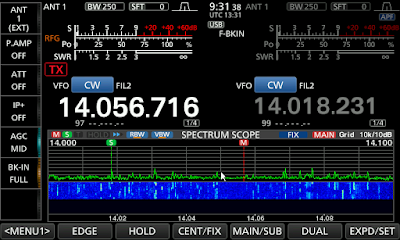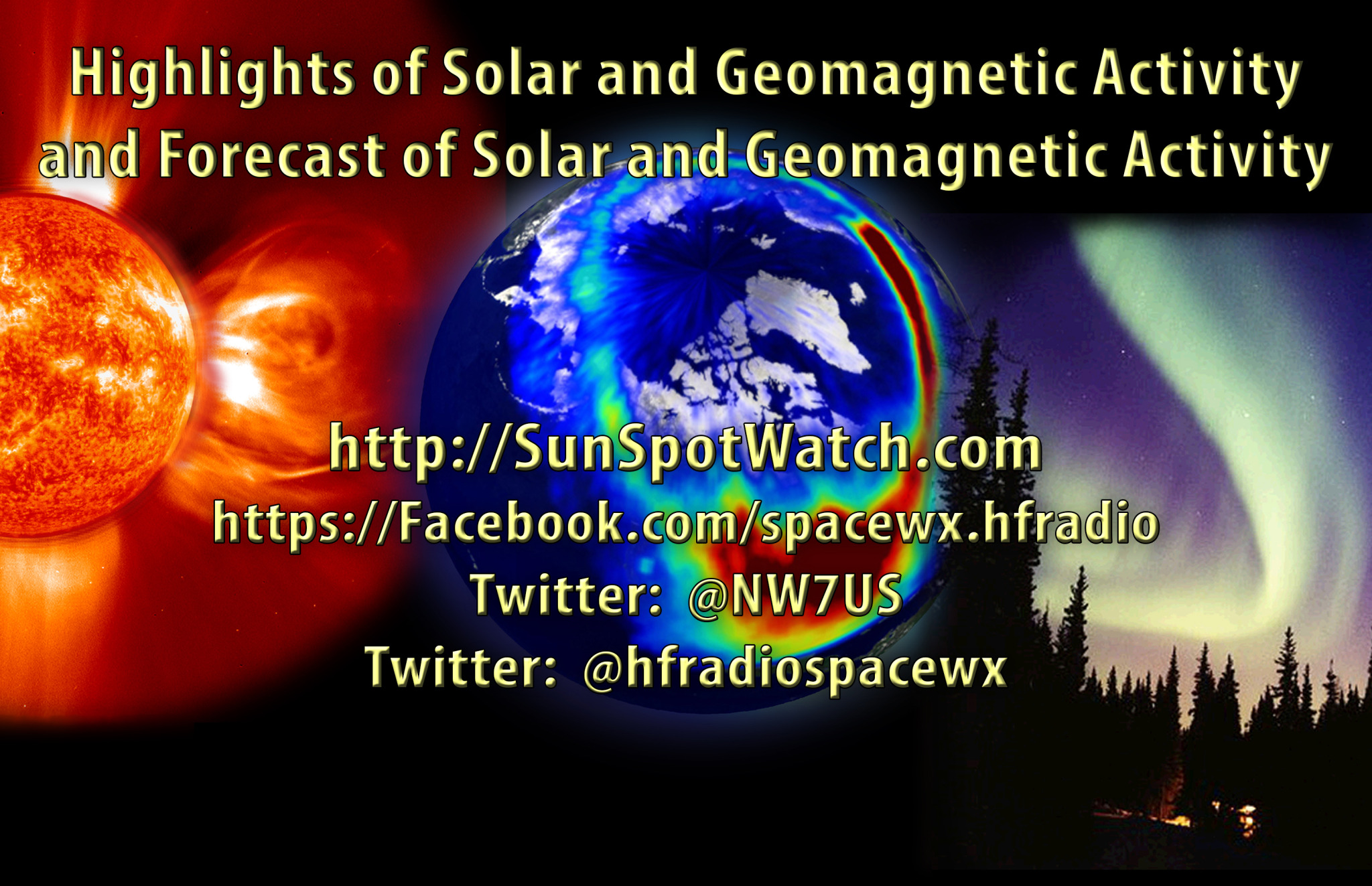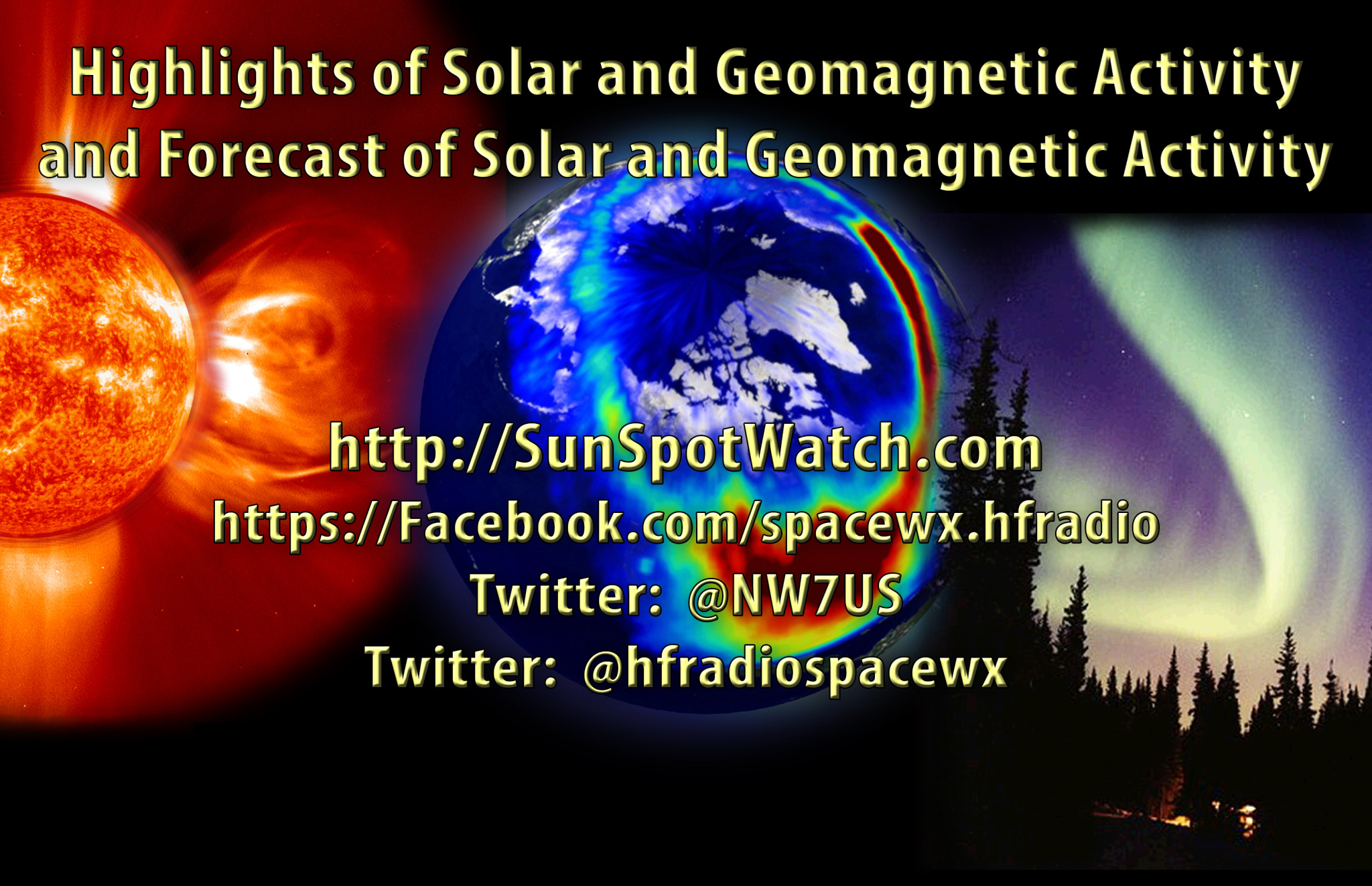 Weekly Propagation Summary – 2020 Mar 30 16:10 UTC
Weekly Propagation Summary – 2020 Mar 30 16:10 UTC
Here is this week’s space weather and geophysical report, issued 2020 Mar 30 0104 UTC.
Highlights of Solar and Geomagnetic Activity 23 – 29 March 2020
Solar activity was very low throughout the period. No active regions with sunspots were observed and no earth-directed CMEs were detected.
No proton events were observed at geosynchronous orbit.
The greater than 2 MeV electron flux at geosynchronous orbit reached high levels on 23-26 Mar and moderate levels were observed on 27-29 Mar.
Geomagnetic field activity was at quiet or quiet to unsettled levels throughout the period.
Forecast of Solar and Geomagnetic Activity 30 March – 25 April 2020
Solar activity is expected to be very low throughout the outlook period.
No proton events are expected at geosynchronous orbit.
The greater than 2 MeV electron flux at geosynchronous orbit is expected to reach high levels on 19-22 Apr, and normal to moderate levels are expected to prevail throughout the remainder of the outlook period.
Geomagnetic field activity is expected to reach active levels on 30-31 Mar due to CH HSS influence. Generally quiet or quiet to unsettled conditions are expected to prevail throughout the remainder of the outlook period.
Don’t forget to visit our live space weather and radio propagation web site, at: http://SunSpotWatch.com/
Live Aurora mapping is at http://aurora.sunspotwatch.com/
If you are on Twitter, please follow these two users: 1. https://Twitter.com/NW7US 2. https://Twitter.com/hfradiospacewx
– – – – – – – – – – – – –
Be sure to subscribe to our space weather and propagation email group, on Groups.io
https://groups.io/g/propagation-and-space-weather
Spread the word!
– – – – – – – – – – – – –
Links of interest:
+ Amazon space weather books: http://g.nw7us.us/fbssw-aSWSC
+ https://Twitter.com/NW7US
+ https://Twitter.com/hfradiospacewx
Space Weather and Ham Radio YouTube Channel News:
I am working on launching a YouTube channel overhaul, that includes series of videos about space weather, radio signal propagation, and more.
Additionally, I am working on improving the educational efforts via the email, Facebook, YouTube, Tumblr, and other activities.
You can help!
Please consider becoming a Patron of these space weather and radio communications services, beginning with the YouTube channel:
https://www.patreon.com/NW7US
The YouTube channel:
https://YouTube.com/NW7US
..
Visit, subscribe: NW7US Radio Communications and Propagation YouTube Channel
 ICQ Podcast Episode 321 – Why Coax Fails
ICQ Podcast Episode 321 – Why Coax Fails
In this episode, Martin M1MRB is joined by Leslie Butterfield G0CIB, Edmund Spicer M0MNG, Dan Romanchik KB6NU and Ruth Willet KM4LAO to discuss the latest Amateur / Ham Radio news. Colin M6BOY rounds up the news in brief and this episode’s feature is - Why Coax Fails
ICQ AMATEUR/HAM RADIO PODCAST DONORS
We would like to thank Dean Sproull (VE5SPR) and our monthly and annual subscription donors for keeping the podcast advert free. To donate, please visit - http://www.icqpodcast.com/donate
- Scientists Create Quantum Sensor that Covers Entire Radio Frequency Spectrum
- It’s Time for Remote Amateur Radio License Exams
- WIA Board Comment
- Need a new hobby? Try amateur radio!
- Fair Lawn Amateur Radio Club Begins Daily Health & Welfare Broadcasts
- Errata to 2020-2024 Amateur Extra-Class Question Pool Released
- Hamvention Names 2020 Award Winners
- EU to Impose VAT on Low Value Parcels
- Ofcom Awards Six New Community Radio Licences
Colin Butler, M6BOY, is the host of the ICQ Podcast, a weekly radio show about Amateur Radio. Contact him at [email protected].
 Ham College 63
Ham College 63
Ham College episode 63 is now available for download.
Extra Class Exam Questions – Part 2
Station restrictions and special operations: restrictions on station location; general operating restrictions; spurious emissions; antenna structure restrictions; RACES operations
1:03:01
George Thomas, W5JDX, is co-host of AmateurLogic.TV, an original amateur radio video program hosted by George Thomas (W5JDX), Tommy Martin (N5ZNO), Peter Berrett (VK3PB), and Emile Diodene (KE5QKR). Contact him at [email protected].
 Hunting For NDBs In CLE254
Hunting For NDBs In CLE254

Once again it's a CLE weekend.
During these stressful times, the CLE might hopefully provide some peaceful relief for you.
'CLE's are 'Co-ordinated Listening Events, and NDB DXers around the world focus their listening time on one small slice of the NDB spectrum.
This time the hunting ground is the 20 slice from 400.0 - 419.9 kHz. kHz
A good target for this one is MOG (404kHz) in Montague, California, up near the border with Oregon. It gets out very well and has been logged from Finland to Hawaii. Its been on-and-off of late so maybe you can catch it while it's on again!
Listen for MOG's upper sideband on 405.027kHz with your receiver in the CW mode.
From CLE coordinator Brian Keyte (G3SIA), comes the following CLE info:
Hello all,
Our 254th Coordinated Listening Event starts on Friday.
This frequency range is not packed with signals for any of us, but if conditions are OK there should be some nice surprises.
Do join in, whether you have days to spare, or only an hour or so over the weekend. Staying at home seems to be essential advice for most of us at present - this could be a great way of spending time there!
Days: Friday 27 March - Monday 30 March 2020
Times: Start and end at midday your LOCAL time
(Many of us will be changing our home clocks this weekend -
however UTC time continues unaffected)
Range: 400 - 419.9 kHz
Please log all the NDBs that you can identify with nominal (listed) frequencies in the range - it includes 400 kHz, but not 420 kHz - plus any UNIDs that you come across there.
Send your final log to the List (no attachments please and ideally in a plain text email) with ‘FINAL CLE254’ in its title.
Show on each line:
# The Date (e.g. '2020-03-27', etc., or just '27' )
# The Time in UTC (the day changes at 00:00 UTC).
# kHz - the nominal published frequency, if known.
# The Call Ident.
Please show those main items FIRST. Other optional details such as Location and Distance go LATER in the same line.
As always, of course, tell us your own location and brief details of the equipment that you were using during the Event.
We will send the usual 'Any More Logs?' email at about 19:00 UTC on Tuesday so that you can check that your log has been found OK.
Do make sure that your log has arrived on the List by 08:00 UTC on Wednesday 1 April at the very latest.
We hope to complete making the combined results within a day or two.
You can find full details about current and past CLEs from the CLE page http://www.ndblist.info/cle.htm It includes access to CLE254 seeklists for your part of the World, prepared from the previous loggings in Rxx. (Thanks, Martin and Alan, for your help with that)
Good listening
- enjoy the CLE and do take care of yourself and your family.
Brian and Joachim
-----------------------------------------------------------------
From: Brian Keyte G3SIA ndbcle'at'gmail.com
Location: Surrey, SE England (CLE coordinator)
-----------------------------------------------------------------
(If you would like to listen remotely you could use any one remote
receiver for your loggings, stating its location and owner and with their
permission if required. A remote listener may NOT also use another
receiver, local or remote, to make further loggings for the same CLE)
- determine, worldwide, which beacons are actually in service and on-the-air so the online database can be kept up-to-date
- determine, worldwide, which beacons are out-of-service or have gone silent since the last CLE covering this range
- will indicate the state of propagation conditions at the various participant locations
- will give you an indication of how well your LF/MF receiving system is working
- give participants a fun yet challenging activity to keep their listening skills honed
The NDB List Group is a great place to learn more about the 'Art of NDB DXing' or to meet other listeners in your region. There is a lot of good information available there and new members are always very welcome. As well, you can follow the results of other CLE participants from night to night as propagation is always an active topic of discussion.
You need not be an NDB List member to participate in the CLEs and all reports, no matter how small, are of much value to the organizers.
Remember - 'First-time' logs are always VERY welcome!
Reports may be sent to the NDB List Group or e-mailed to CLE co-ordinator, Brian Keyte (G3SIA), whose address appears above. If you are a member of the group, all final results will also be e-mailed and posted there.
Please ... give the CLE a try ... then let us know what NDB's can be heard from your location! Your report can then be added to the worldwide database to help keep it up-to-date.
Have fun and good hunting!
Steve McDonald, VE7SL, is a regular contributor to AmateurRadio.com and writes from British Columbia, Canada. Contact him at [email protected].
 LHS Episode #334: GNURadio Deep Dive
LHS Episode #334: GNURadio Deep Dive

Welcome to Episode #334 of Linux in the Ham Shack. In this deep dive episode, we have a special guest, Derek Kozel, MW0LNA, who takes the hosts and everyone else on a wild ride into the internals of GNURadio. Somehow by the end it all starts to make sense. Learn about SDR, hardware design, DSP, audio path simulation and much more in this informative episode and look for the companion YouTube video to follow. Thanks for listening. We hope you enjoy. Stay safe out there.
73 de The LHS Crew
Russ Woodman, K5TUX, co-hosts the Linux in the Ham Shack podcast which is available for download in both MP3 and OGG audio format. Contact him at [email protected].
 Weekly Propagation Summary – 2020 Mar 23 16:10 UTC
Weekly Propagation Summary – 2020 Mar 23 16:10 UTC
Here is this week’s space weather and geophysical report, issued 2020 Mar 23 0128 UTC.
Highlights of Solar and Geomagnetic Activity 16 – 22 March 2020
Solar activity was very low. The visible disk was spotless. No Earth-directed CMEs were observed during the reporting period.
No proton events were observed at geosynchronous orbit.
The greater than 2 MeV electron flux at geosynchronous orbit reached moderate levels each day of the period with a peak flux of 547 pfu observed at 22/1535 UTC.
Geomagnetic field activity reached active levels on 19 Mar with unsettled levels on 16, 18-22 Mar in response to CH HSS influence. Quiet conditions were observed on 17 Mar.
Forecast of Solar and Geomagnetic Activity 23 March – 18 April 2020
Solar activity is expected to continue at very low levels.
No proton events are expected at geosynchronous orbit.
The greater than 2 MeV electron flux at geosynchronous orbit is expected to reach moderate levels throughout the period in response to recurrent CH HSS influence.
Geomagnetic field activity is expected to reach active levels on 27 Mar and 15 Apr, with unsettled conditions anticipated for 23, 27-29 Mar and 15-18 Apr due to CH HSS effects. Quiet conditions are expected for the remainder of the outlook period.
Don’t forget to visit our live space weather and radio propagation web site, at: http://SunSpotWatch.com/
Live Aurora mapping is at http://aurora.sunspotwatch.com/
If you are on Twitter, please follow these two users: 1. https://Twitter.com/NW7US 2. https://Twitter.com/hfradiospacewx
– – – – – – – – – – – – –
Be sure to subscribe to our space weather and propagation email group, on Groups.io
https://groups.io/g/propagation-and-space-weather
Spread the word!
– – – – – – – – – – – – –
Links of interest:
+ Amazon space weather books: http://g.nw7us.us/fbssw-aSWSC
+ https://Twitter.com/NW7US
+ https://Twitter.com/hfradiospacewx
Space Weather and Ham Radio YouTube Channel News:
I am working on launching a YouTube channel overhaul, that includes series of videos about space weather, radio signal propagation, and more.
Additionally, I am working on improving the educational efforts via the email, Facebook, YouTube, Tumblr, and other activities.
You can help!
Please consider becoming a Patron of these space weather and radio communications services, beginning with the YouTube channel:
https://www.patreon.com/NW7US
The YouTube channel:
https://YouTube.com/NW7US
..
Visit, subscribe: NW7US Radio Communications and Propagation YouTube Channel
 The weekend of radio
The weekend of radio
 |
| Russian CW contest was Rockin the band |
So how was the Virginia QSO Party you ask.........well on 20m things were really hopping but not with the QSO Party but the Russin CW contest. The band was packed with DX and very tempting to just jump in BUT I wanted to keep up with my goal of working all the QSO parties this year, I jumped up to 40m and worked a few Virginia station ground wave from my location. I was able to get 4 in the logbook only on 40m as I did have some "to do" items that needed to be done around the house. I checked in again on Sunday and went back to 40m but the strange thing was on Sunday I could only hear the stations making contact with stations in Virginia?? Oh well, propagation can be a funny thing at times.
Other related radio adventures were I was able to work fellow blogger John AE5X from Texas. John was working POTA and activating location KFF-3054. I was not able to hear John at all on CW but it was great he grabbed his laptop for the trip as we made contact on FT8. On Sunday I checked out the POTA cluster to see what was up and I was able to contact KB3WAV and at the time I did not realize it until I went to the POTA website and found that Kerri is a top leader for POTA activations.
His stats are:
Activations 1266
Unique parks 446
Total contacts 4730 Now this is an old number I would believe after this past weekend activation.
I also noticed on Sunday 20m was dead again as the Russian Contest had ended but it goes to show propagation is alive and well.
If you are like me and trying to work all the QSO parties this year by taking part in ARRL's State QSO party challenge make sure your seatbelt on during the weekend of April 3-5. The QSO Parties for the weekend are Nebraska, Missouri, Florida, Mississippi, and Louisiana!
Finally, on a lighter note, today is a milestone for me.........I'm 60 today! My car dealership sent me an email birthday wish bright and early this morning way before anyone would have been at work. Darn computers programs just don't sleep...:))
Mike Weir, VE9KK, is a regular contributor to AmateurRadio.com and writes from New Brunswick, Canada. Contact him at [email protected].















